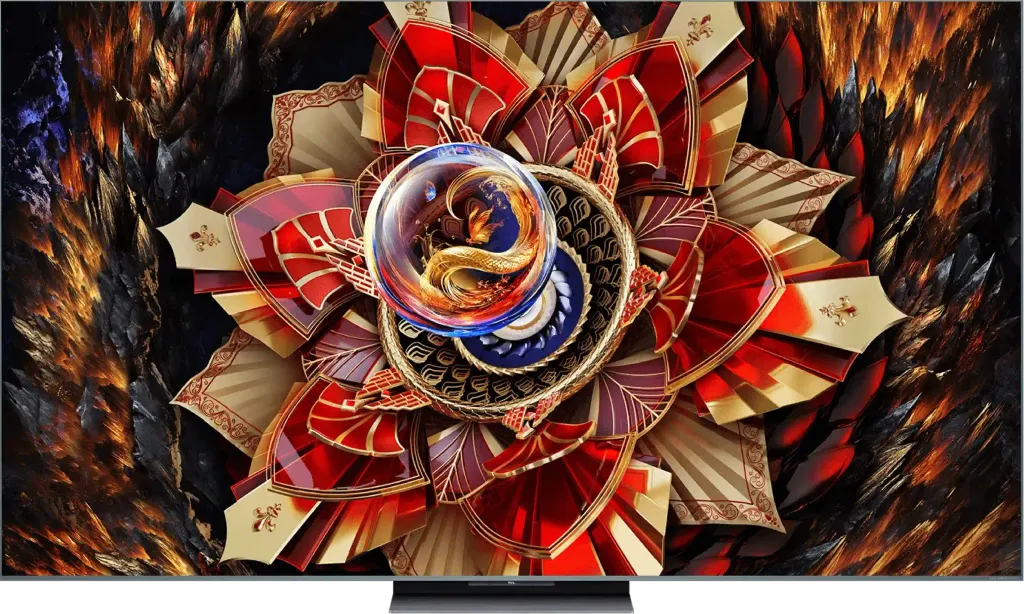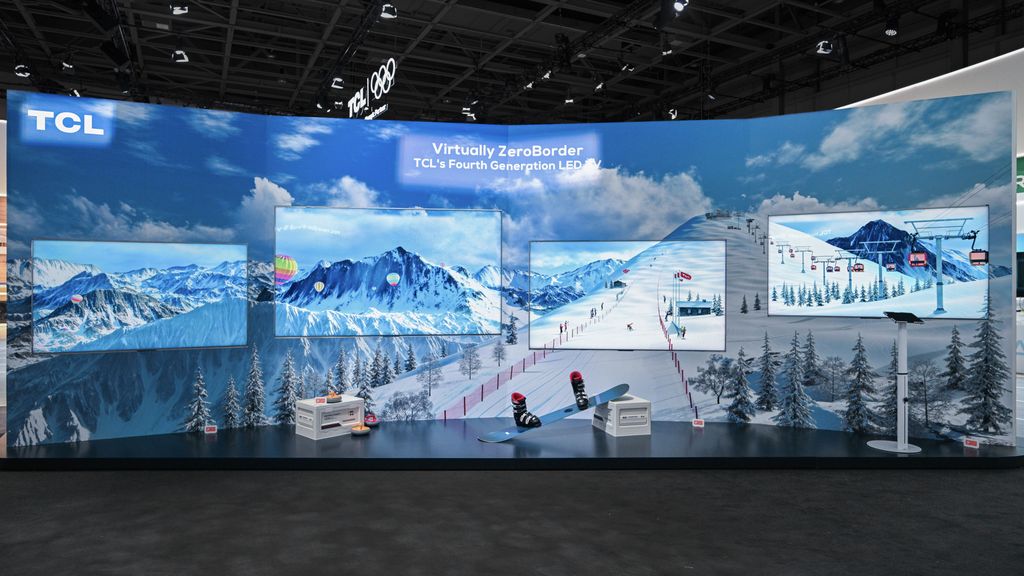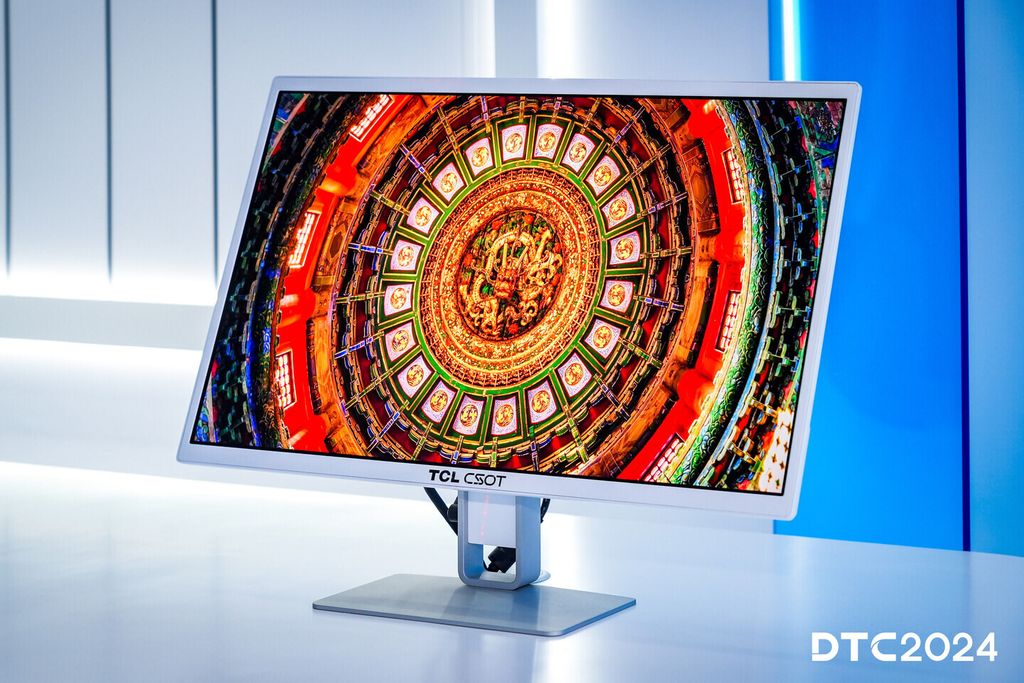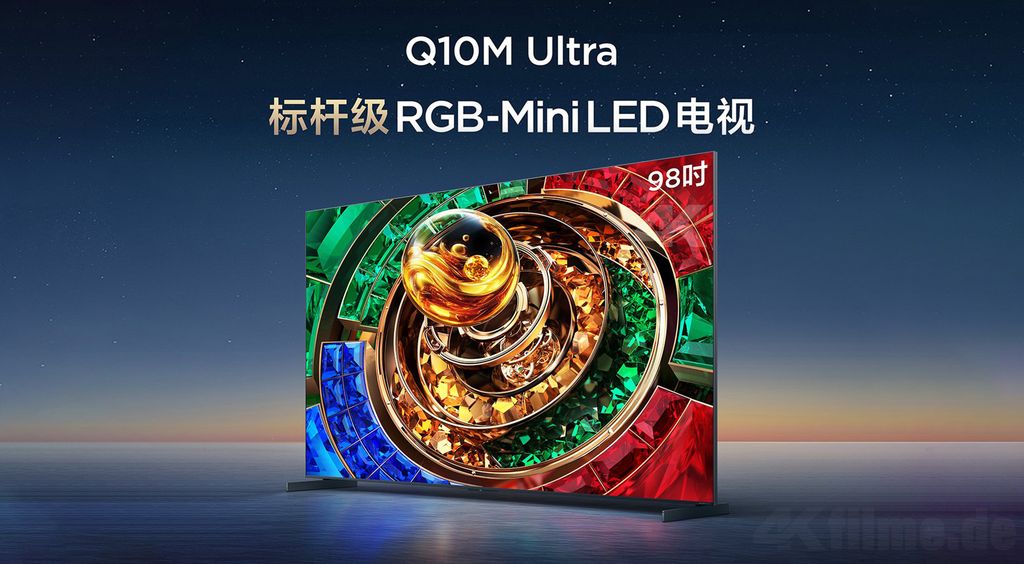- Matching (Score)
- Our verdict
- Competing TVs
- TV appearance
- Where to buy
- Contrast and black detail
- HDR effect quality
- Factory color reproduction
- Color reproduction after calibration
- Smoothness of tonal transitions
- Image scaling and smoothness of tonal transitions
- Blur and motion smoothness
- Console compatibility and gaming features
- Input lag
- Compatibility with PC
- Viewing angles
- Daytime performance
- TV features
- Apps
- Playing files from USB
- Sound
- Panel details
Panel type: LCD VA Refresh rate: 144Hz Brand: TCL Resolution: 3840x2160 System: Google TV Model year: 2025
TCL in 2025 is focusing on Mini-LEDs like never before, and C9K is the flagship of this line – the highest model in the entire portfolio. If you're familiar with C8K, you can consider it a stronger sibling – here we get an enhanced version with an even greater number of backlight zones. Also onboard is a WHVA matrix and an audio system developed in collaboration with Bang & Olufsen. On paper, it looks like a complete television – with strong picture quality and premium-class sound. But has TCL really managed to create a Mini-LED king… for a fraction of the price that competitors demand? You will find the answer in this review.
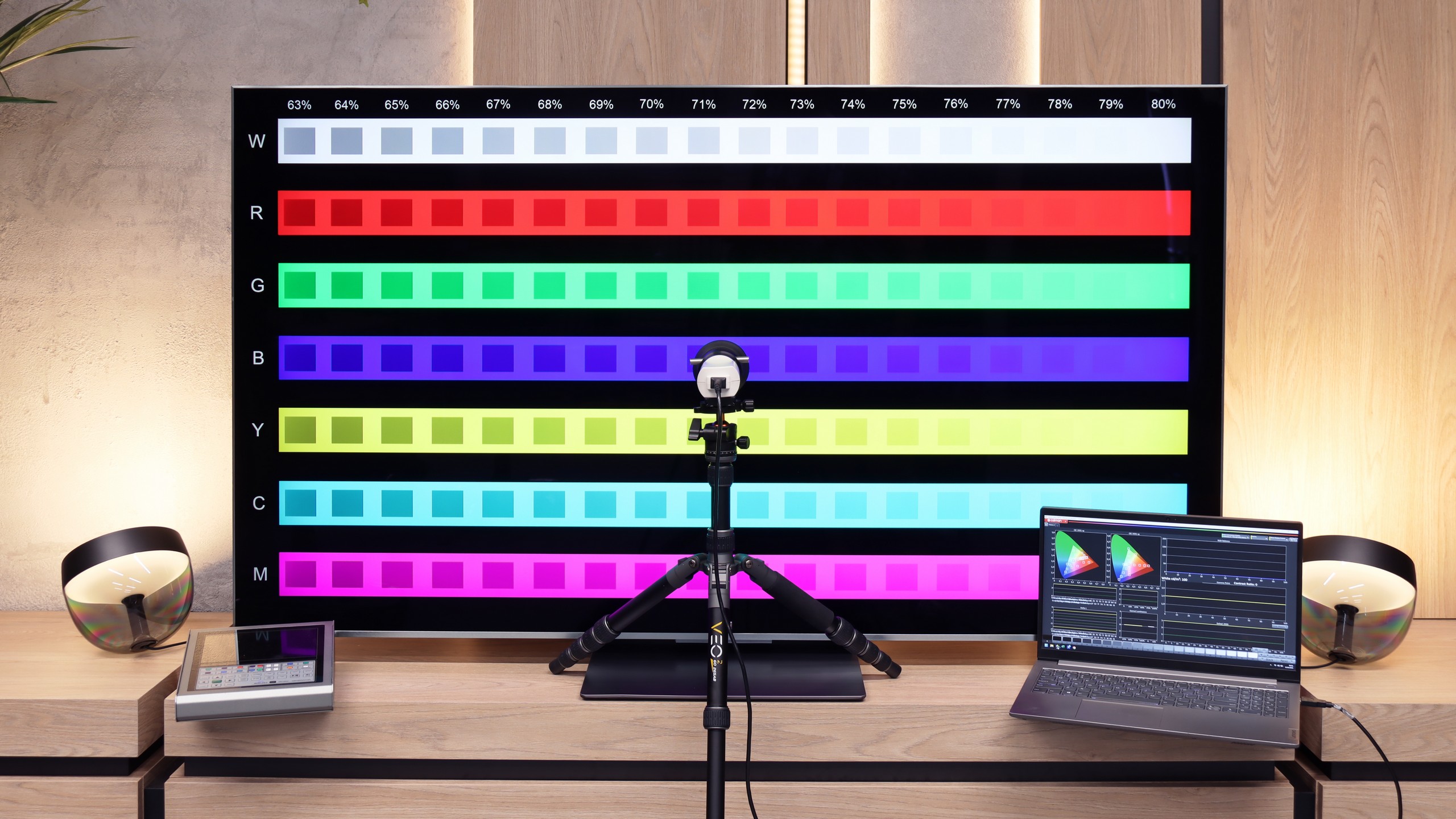
TCL C9K - Our verdict
7.7
Overall rating
The TCL C9K is a television that on paper looks like a show of strength from the manufacturer – thousands of Mini-LED zones, WHVA panel, audio system from Bang & Olufsen, full support for HDR formats, gaming at 144 Hz, and even 288 Hz at lower resolutions. It’s clear that TCL wanted to throw in absolutely everything they had best. And indeed – in many aspects, the C9K can impress. The brightness is enormous, HDR in large scenes can be breathtaking, motion smoothness and gaming capabilities are at a top level, and the sound – considering it’s built into the television – sounds really good. This is a device that can easily be seen as a home entertainment center. But there is also another side to the coin. Brightness management simply falters despite the amazing technical specifications – smaller details often get lost in the shadows or are blown out. And although synthetic tests of contrast or brightness perform exceptionally well, in everyday viewing of movies and series, the effect is no longer so impressive.
To summarize briefly: the C9K is a television full of contrasts – literally and figuratively. It can provide experiences close to top screens, but it's still evident that TCL needs to work on the software and optimization. If someone is looking for a screen for gaming, sports, or spectacular blockbusters – they will be delighted. However, if one expects perfect reproduction of the director's vision and thinks they have managed to buy an absolutely top model at half the price of the competition, unfortunately, they will be disappointed. It's a pity, because the technological potential here is truly vast – it just lacked a bit of common sense in its utilization.
Advantages
Very good contrast and black
Very high brightness
Support for all HDR formats including Dolby Vision
Fast 144Hz panel - for gaming and sports fans
Many features for gamers: VRR, ALLM, low input lag, etc.
GoogleTV operating system with a wide range of applications
Great sound branded by Bang & Olufsen
Improved viewing angles thanks to WHVA panel
Disadvantages
Local dimming needs improvement
Only 2 HDMI 2.1 ports
No recording function from built-in tuners and no PiP
No smaller variants, e.g., 55"
Movies and series in UHD quality
7.4
Classic TV, YouTube
7.0
Sports broadcasts (TV and apps)
6.8
Gaming on console
8.9
TV as a computer monitor
8.6
Watching in bright light
7.0
Utility functions
7.7
Apps
9.6
Sound quality
7.9
Complete the survey to find out what fits your preferences
TCL C9K - Competing TVs in this price range
TCL C9K - TV appearance
HDMI inputs: 2 x HDMI 2.0, 2 x HDMI 2.1 (48Gbps) Outputs: Toslink (Optical audio), eARC (HDMI), ARC (HDMI) Network Interfaces: Wi-Fi 2.4GHz, Wi-Fi 5GHz, Ethernet (LAN) 100Mbps
Build quality: Premium
Stand type: Central
Bezel color: Silver
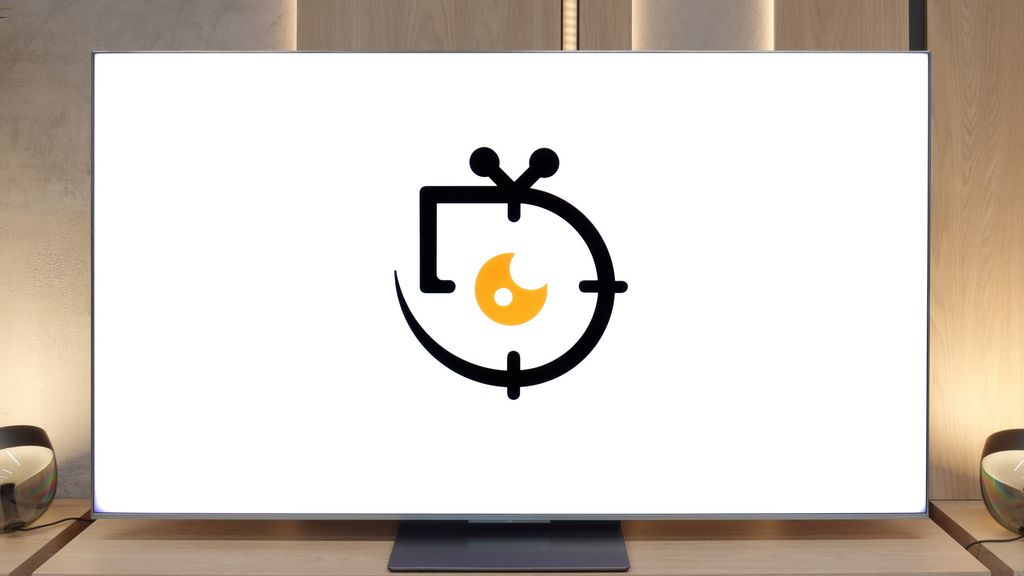
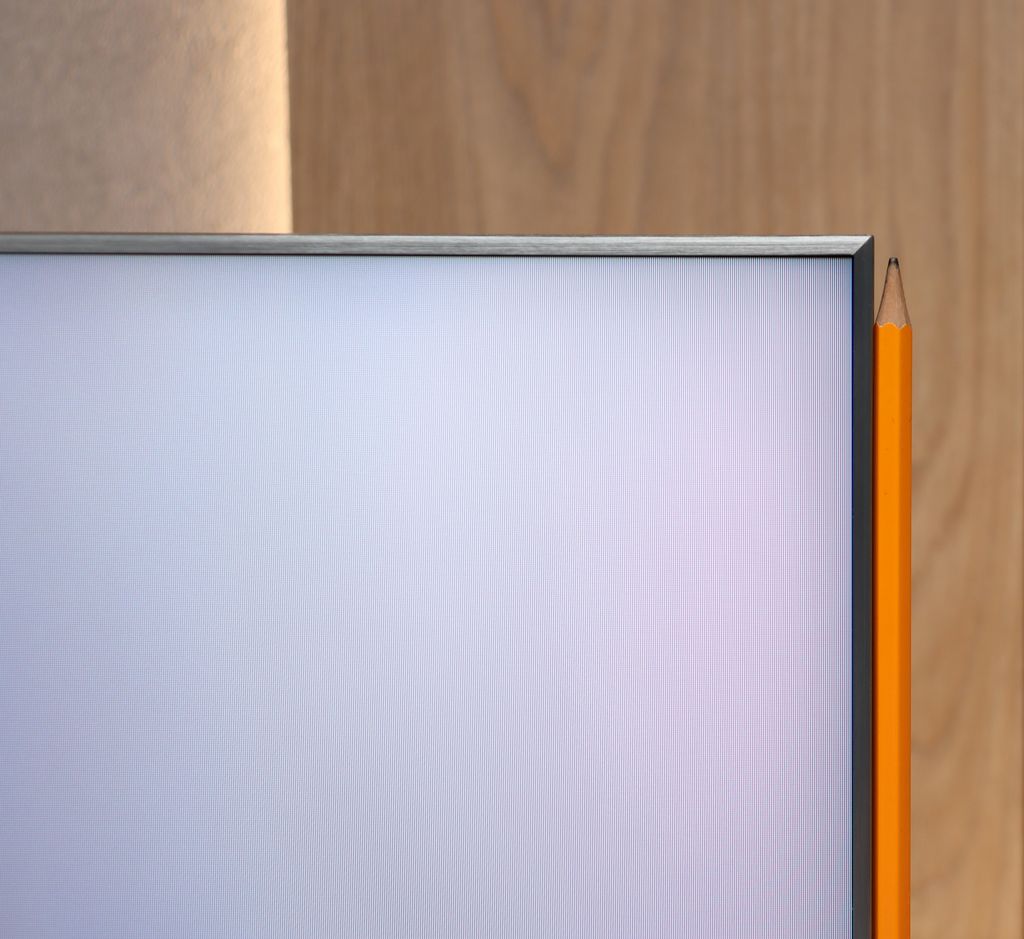
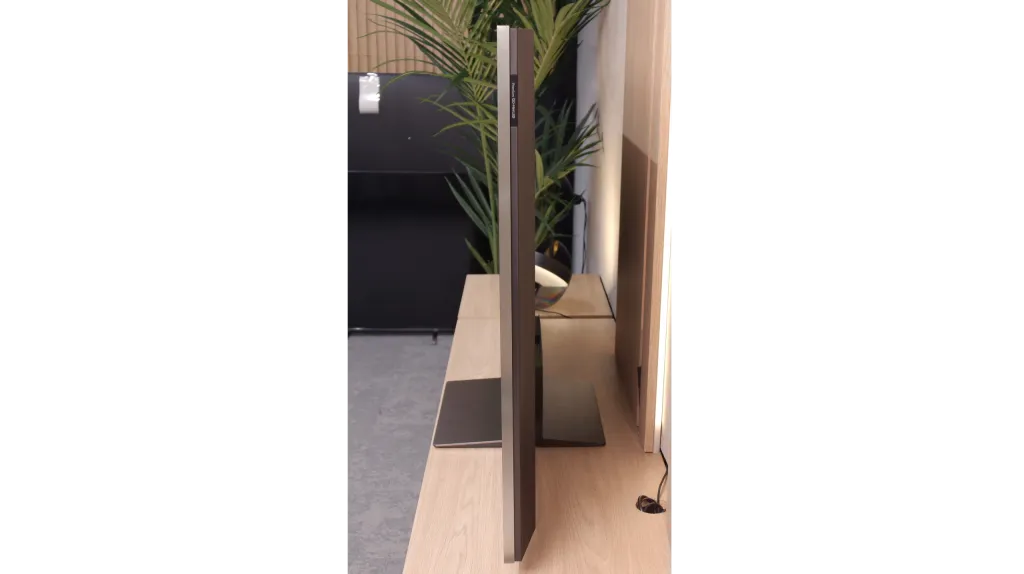
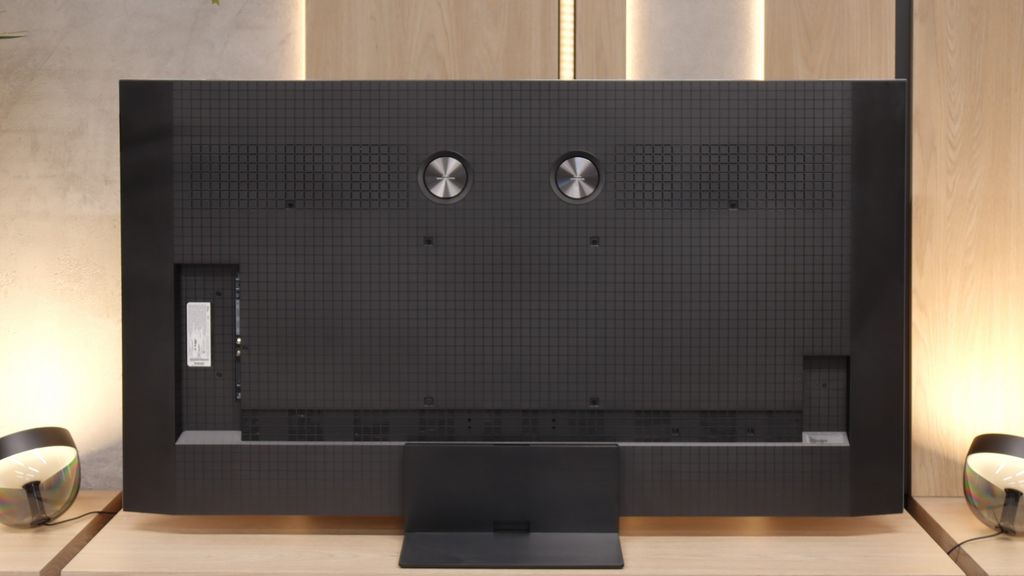
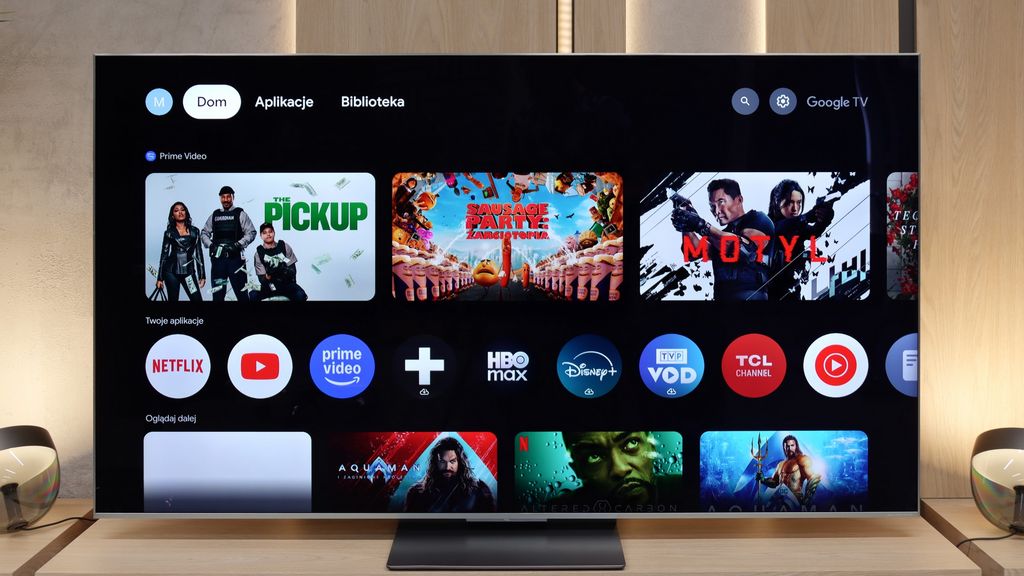
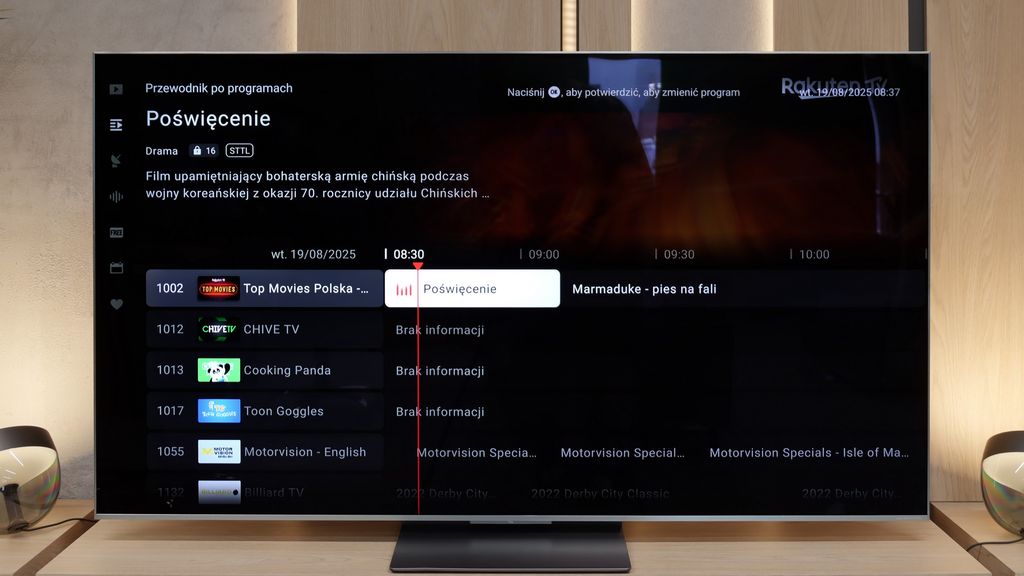
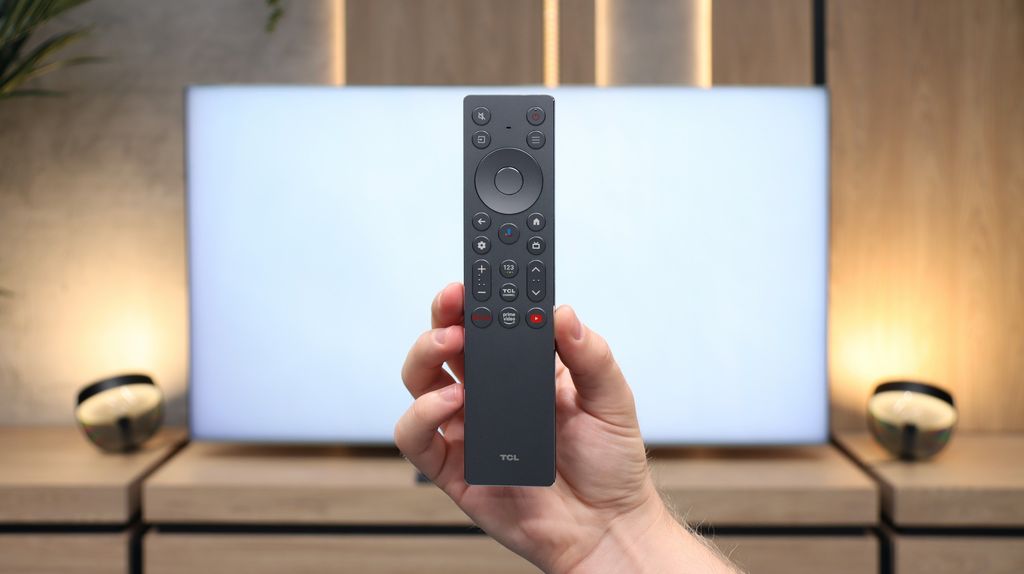
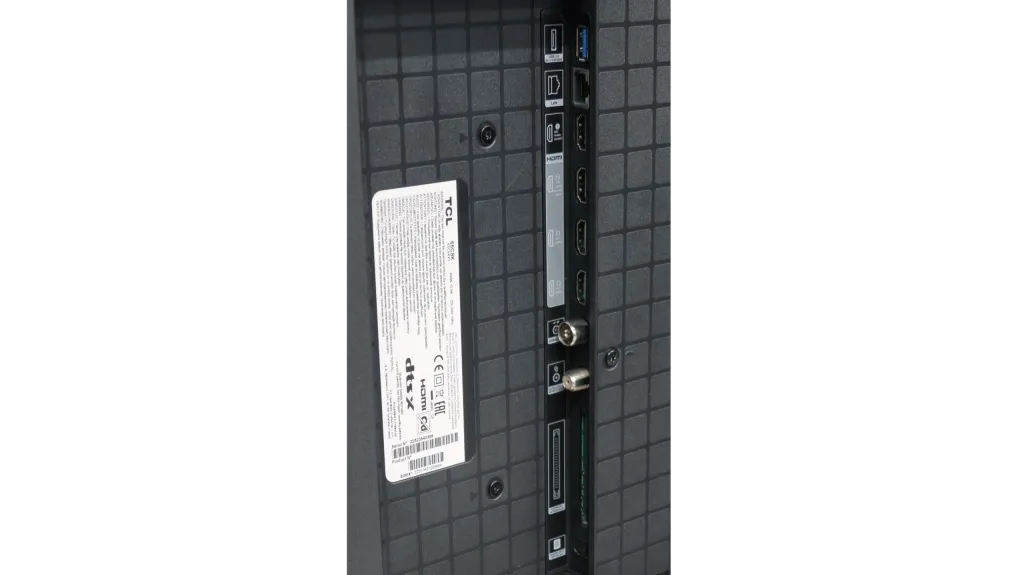
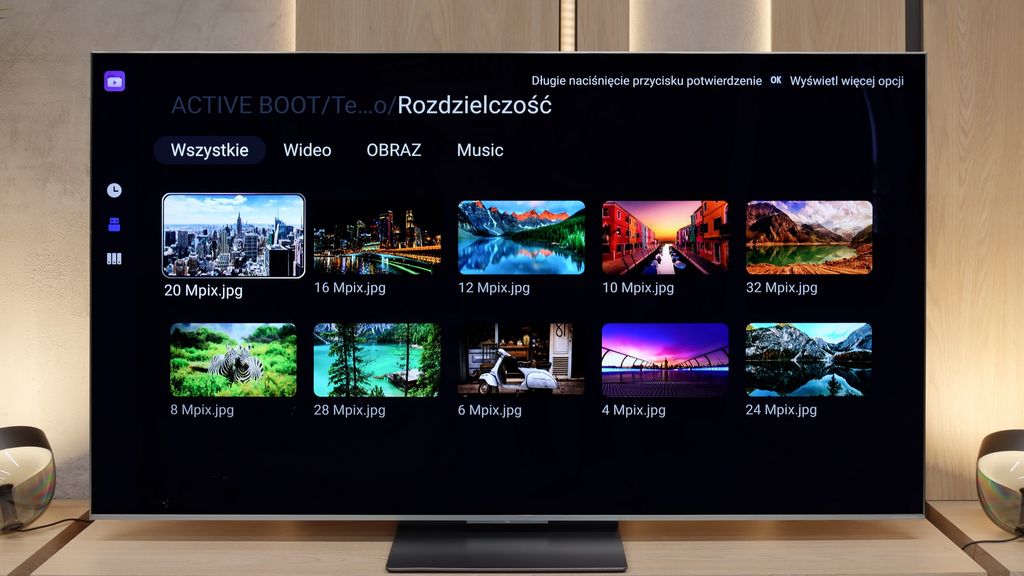
Stand: Fixed
Flat design: Yes
Accessories: Stand
At first glance, the TCL C9K closely resembles its cousin from the same line – the C8K. The design is almost identical: quite massive, yet modern at the same time. The difference is visible in the details – the frame color on the C9K leans more towards silver, while on the C8K we had graphite. Just like in the cheaper model, here we also get Zero Border technology, which means the screen is not surrounded by a classic black border. The effect from the front is impressive – the picture seems to simply "grow" from the surface of the television. The back of the construction remains massive, but it has been designed so that the television can be easily hung flat on the wall. The central stand included in the set is also a plus – solid, stable, and made with the same level of care as the television itself. It is definitely not an "afterthought" addition, but a component that fits the whole.
Buy at the best price
Select size:
TCL C9K - Contrast and black detail
8.1/10
Local dimming function: Yes, number of zones: 3024 (42 x 72)

Result
459,000:1

Result
72,750:1

Result
30,350:1

Result
9,800:1

Result
12,200:1
Visibility of details in the lights:

What immediately distinguishes the C9K from the C8K model is the number of local dimming zones. In the 65-inch version, we counted… over 3000! One must admit – this is a true showcase of TCL's strength, cramming literally everything they had into this television. On paper, it makes a huge impression and indeed – in less demanding film scenes, the blacks look fantastic. The level is absolutely top-notch, and the separation of lights from dark parts of the image can be breathtaking. The problem is that this impressive specification does not always translate into practice. In our tests, we noticed situations where the C9K, despite having a greater number of zones, stumbled into contrast traps and performed… worse than the C8K. For instance, it cannot perfectly dim the true black bars in 21:9 format films (those with black bars on the top and bottom). Sounds strange? Unfortunately, this is the result of a lack of optimization – the hardware is "packed" with technology, but the algorithms do not always keep up with utilizing that potential.
Don't get us wrong – black is a strong point of the C9K and in many scenes, it simply looks fantastic. In synthetic measurements, the contrast is outstanding, coming close to the level of the best TVs on the market. But in real cinema usage, those numbers do not always correspond to a better experience than in its cheaper cousin. And that is probably the biggest disappointment – because the potential was enormous.
Halo effect and black detail visibility:
TCL C9K - HDR effect quality
6.9/10
Supported formats: HDR10, HDR10+, Dolby Vision, Dolby Vision IQ, HLG Color gamut coverage: DCI P3: 96.5%, Bt.2020: 80.5%
Luminance measurements in HDR:

Result
1425 nit

Result
531 nit

Result
1277 nit

Result
331 nit

Result
1424 nit
As we mentioned with black and contrast – the C9K can make a huge impression in synthetic tests. Our measurements showed that on a screen 10% filled with white, the television is capable of squeezing out… 4000 nits of brightness! It sounds astronomical, but – and here, unfortunately, the pattern repeats – the numbers say one thing, and practice says another. In real movie scenes, the situation looks different. At best, when the light effects occupy a large part of the image and the local dimming algorithm does not have to think too hard about what to do with thousands of zones – the effect is really good. At that point, the C9K can reach around 1500 nits, which provides a pleasant, intense flash and can indeed make a positive impression.
The problem starts with smaller elements – such as stars in the sky, the moon, or single reflections. That’s when the proverbial cat comes out of the bag: the algorithms are not yet refined, and brightness drops to even 400–500 nits. That’s a huge difference compared to the potential 4000 nits we saw in laboratory tests. Why does this happen? Most likely, the television is trying to protect the blacks in this way and minimize the halo effect around bright objects. Unfortunately, this comes at the cost of details – some details simply vanish, and the scene loses its nature.
Scene from the movie “Pan” (about 2800 nits)

Scene from the movie “Billy Lynn” (about 1100 nits)

And how does the TCL C9K perform in a true cinematic battle when we compare it to top-tier televisions, like OLEDs? Exactly as our previous tests showed. In scenes filled with light and color – like in the movie The King that you can see in our pictures – the C9K can shine. The brightness is so impressive that it’s hard to distinguish it from the absolute top screens available on the market. Minor color discrepancies can sometimes slightly spoil the effect, but the display of intensity can truly be blinding. We had a similar impression during the fireworks sequence in Billy Lynn’s Long Halftime Walk. Here, both the strong light effects and the face of the main character were rendered really well.
Unfortunately, when we move our gaze to the darker parts of the frame – the faces of supporting actors or shadows in the background – it’s clear that the television dims them too aggressively. The effect? The contrast appears deeper, but some details simply get lost. For many people, this can be an asset, as the black seems more “cinematic.” However, there are also situations where something important slips away because of this. And then… well, in a horror movie, you might get an additional scare, because a dark figure lurking in the shadow will appear on the screen too late 😉.
HDR luminance chart:
HDR luminance
Here the TCL C9K deserves a big plus – it supports all HDR formats available on the market: HDR10, HDR10+, HLG, and Dolby Vision. This means that regardless of the source – whether you're watching Netflix, UHD Blu-ray, or television broadcasts – you can always count on compatibility and no unpleasant surprises. The TV itself is bright enough that even without support for dynamic metadata, it can make a great impression. However, what's important – since we already have HDR10+ and Dolby Vision on board, it's worth utilizing them. In scenes where details in bright and dark areas of the image matter, dynamic metadata can indeed bring out more details and make the viewing experience feel fuller. It's just a shame that the dynamic tone mapping feature in TCL's implementation has been unfortunate – instead of enhancing the effect, it simply brightens the entire screen. In practice, it does more harm than good, which is why we definitely do not recommend using it. Perhaps if it were refined, static HDR10 material would look better, but in its current form, it's better to just turn it off.
Static HDR10

Dynamic: Dolby Vision

Factory color reproduction
4.5/10
For color tests, as always, we reached for the Filmmaker mode – a new feature in TCL TVs for 2025. And while the direction itself is a step in the right direction, the execution leaves much to be desired. The white balance in SDR content turned out to be too warm – there was an excess of red. On the other hand, in HDR, it went in the opposite direction: the image became excessively blue. The Colour Checker test revealed quite a few color errors that were noticeable to the naked eye. An even bigger problem turned out to be what we mentioned above – brightness management. Regardless of whether we were watching SDR or HDR content, the image tended to blow out the entire scene, giving it an unnatural, even grotesque character. It's hard to call this a "director-created" mode – because the director has certainly never seen such an image.
Color reproduction after calibration
7/10
After calibration, we finally managed to tame the white balance – and it immediately translated into a more natural image. Colors finally started to look the way they should, and the overall presentation was incomparably better than in the factory settings. In other words – it’s worth taking a moment to improve this, as the gain is truly significant. The gamma responsible for managing brightness was also brought into order in SDR content, and the effect was more than satisfying. Unfortunately, when we turned on HDR materials, the situation quickly became complicated. No matter how we set the local dimming, the television had a tendency to do what it liked with the image – either it overexposed everything or dimmed the darkest parts too much. Exactly as we saw in the scene from the movie Billy Lynn. So, the color improvement after calibration makes a great impression, but brightness management in HDR remains the Achilles' heel of C9K and presents a certain technological limitation.


TCL C9K - Smoothness of tonal transitions
8.7/10
In terms of the smoothness of tonal transitions, TCL C9K performs really well. In more challenging movie scenes, there is no typical color banding that can break immersion even in more expensive TVs. Perhaps slight issues can be noticed in the brightest parts – for example, in scenes from the movie Kingstone – but these are nuances. For the vast majority of viewers, especially with 4K content, color grading will look smooth and practically unnoticeable.








Image scaling and smoothness of tonal transitions
5.5/10
Smooth transition function
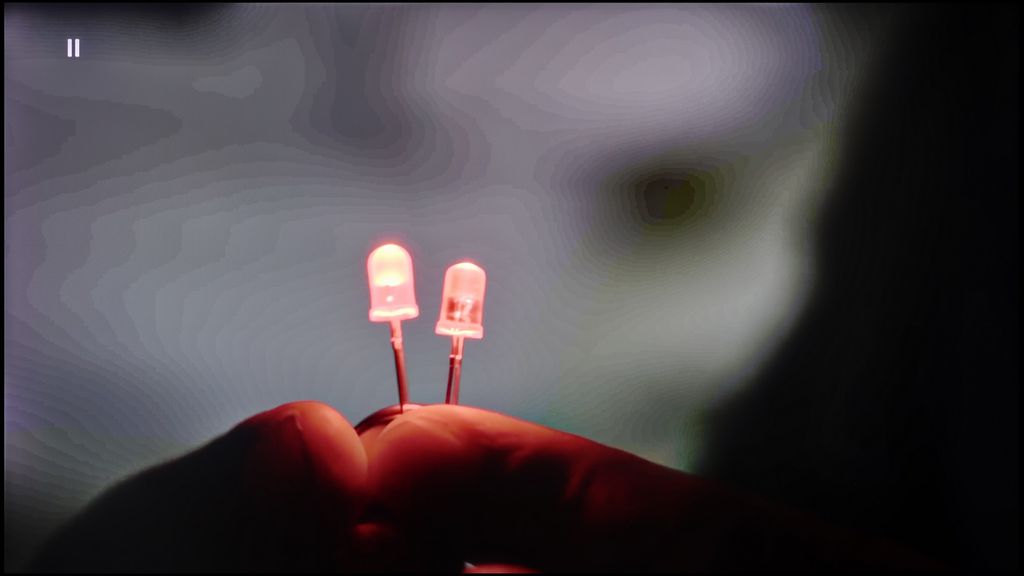
Image without overscan on the SD signal

Digital image processing in TCL C9K is quite mediocre. The tonal smoothing feature seems to be present, but turning it on practically changes nothing – color bands are still visible, and it can unintentionally highlight elements we would prefer to hide, such as textures of objects. Fortunately, it doesn’t remove film grain, but that’s small comfort since the effects are still poor. Therefore, it's hard to recommend using this option.
On the other hand, image scaling performs much better. Lower quality materials look quite decent – characters and backgrounds are presented clearly, although, of course, with sources at 576p, physics cannot be fooled. Sometimes, characteristic aliasing on objects appears, but that’s the fault of the source itself, not the algorithm. A plus for not having issues with overscan – the image is not artificially cropped or enlarged.
TCL C9K - Blur and motion smoothness
7.8/10
Maximum refresh rate of the panel: 144Hz
Film motion smoothing option: Yes
Blur reduction option: Yes
BFI function 60Hz: Yes, 120Hz (double contours)
BFI function 120Hz: Yes, 240Hz (double contours)
Brightness drop with BFI: 51%
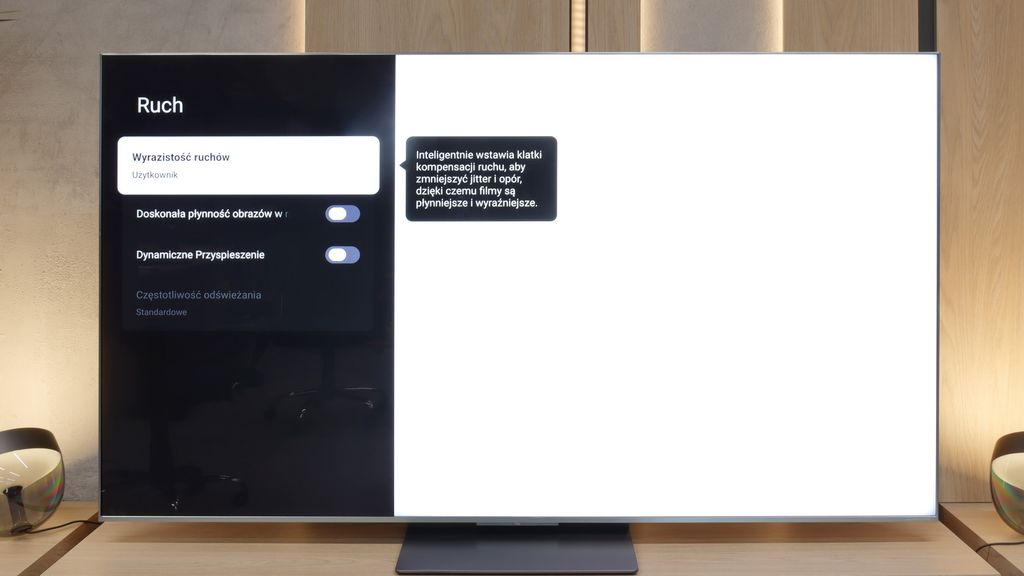
Like the C8K, the C9K is also a really fast television – both figuratively and literally. It features a 4K panel with a refresh rate of 144 Hz, and at lower resolutions, the display can even ramp up to 288 Hz. This speed translates into practice – when watching sports or playing games, the image looks very smooth and clear. Additionally, in films, we get an extra motion smoother called Motion Clarity, which allows us to adjust the fluidity to our own preferences – from the cinematic "judder" frame to almost theatrical smoothness.
Blur (native resolution, maximum refresh rate):



Blur (BFI function enabled):



Blur (1080p@288Hz):


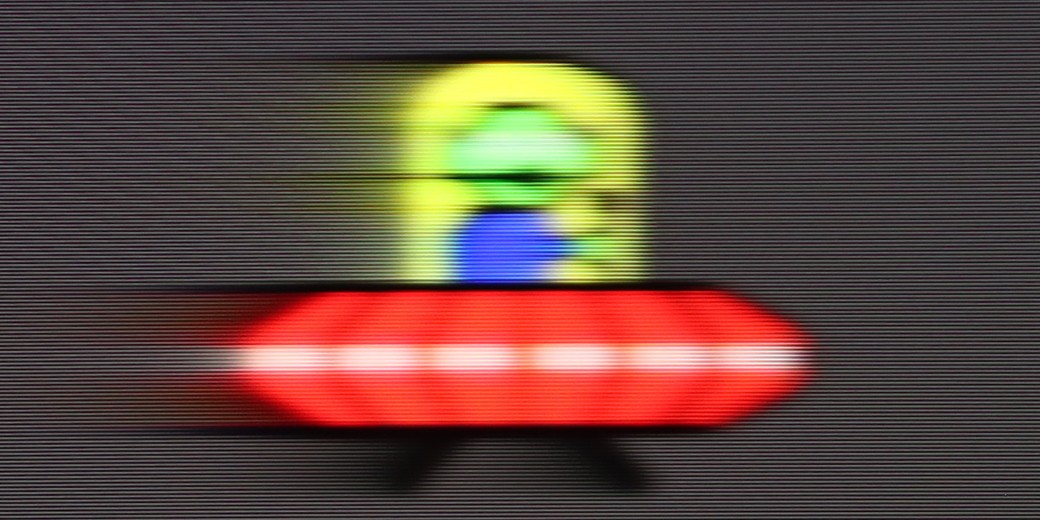
When it comes to smearing itself, the C9K performs moderately. You can see the typical "clouding" characteristic of LCD VA panels, especially on darker backgrounds – and this is true whether we are talking about 144, 120, or even 288 Hz. This effect will be most noticeable to those sensitive to motion smoothness, but it shouldn't be a problem in everyday viewing and does not detract from the overall good impression.
TCL C9K - Console compatibility and gaming features
9.8/10
ALLM: Yes
VRR: Yes
VRR range: 48 - 288Hz
Dolby Vision Game Mode: Yes
Correct implementation of HGIG: Yes
1080p@120Hz: Yes
1440p@120Hz: Yes
4K@120Hz: Yes
Game bar: Yes

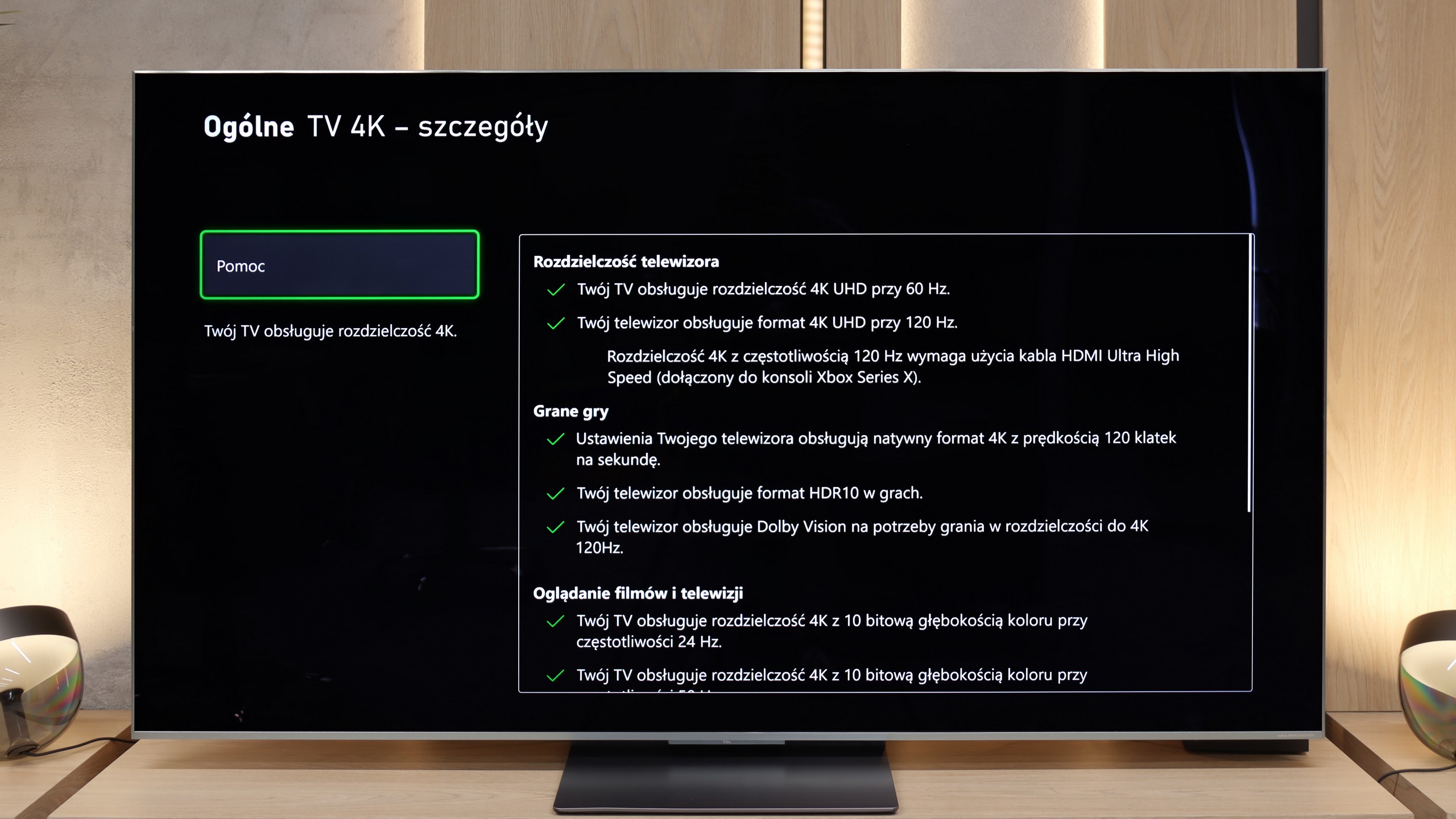
For gaming, the TCL C9K is a complete tool. Here we have two (out of four) HDMI 2.1 ports with full bandwidth of 48 Gbps, so all key technologies work: VRR (variable refresh rate) and ALLM (automatic low latency mode). Additionally, the manufacturer added a really intuitive Game Bar, which allows you to quickly preview the most important parameters and adjust settings without digging through the menu. Also, TCL's policy is a plus – the TV is not afraid of any HDR formats, even in game mode. Whether it's HGiG or Dolby Vision for the Xbox Series S/X console – everything works as it should, giving the player wide freedom.
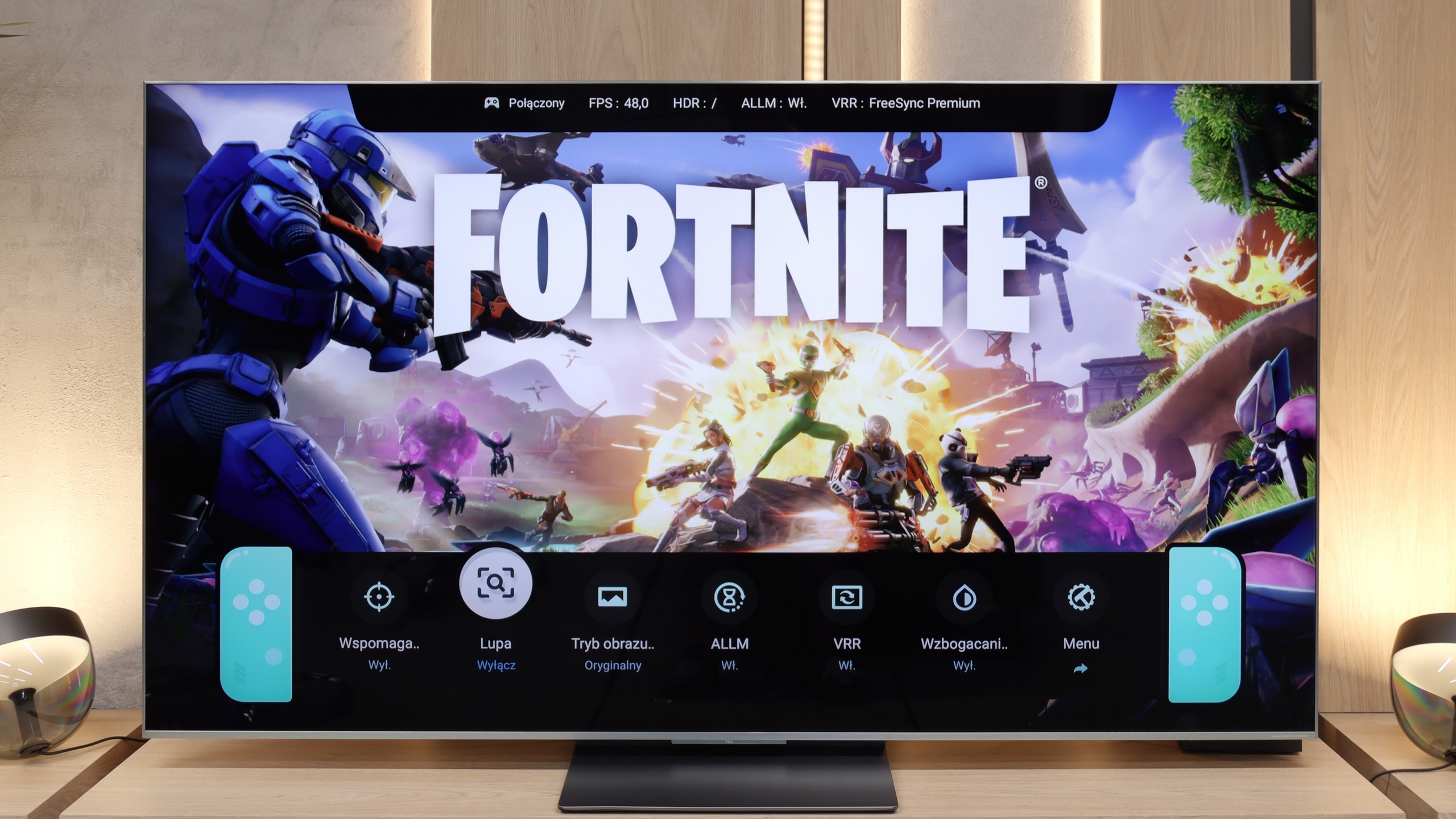


TCL C9K - Input lag
9.8/10
In terms of input lag, the TCL C9K performs exceptionally well. With 120 Hz content, the lag is just 7 ms, placing it among the very best TVs available on the market. Naturally, with 60 Hz materials, the input lag rises to about 15-16 ms, but in practice, this has little impact on the final responsiveness of the screen to our actions on the pad.
| SDR | HDR | Dolby Vision |
|---|---|---|
| 1080p60: 16 ms | 2160p60: 16 ms | 2160p60 DV: 16 ms |
| 1080p120: 7 ms | 2160p120: 7 ms | 2160p120 DV: 7 ms |
| 2160p60: 16 ms | ||
| 2160p120: 7 ms |

TCL C9K - Compatibility with PC
8.6/10
Chroma 444 (maximum resolution and refresh rate): Yes
Font clarity: Good
Readability of dark text and shapes: Good
Input lag in PC mode (4K, maximum refresh rate): 7ms
Matrix subpixel arrangement: RGB
Max refresh rate: 144Hz
G-Sync: Yes
In terms of office work, the TCL C9K does not disappoint – thanks to the support for 4:4:4 chroma, the readability of fonts is at a good level, so writing or working with documents should not pose a problem. One could indeed notice slight issues with dimming horizontal lines, but in everyday use, it’s hard to call that a real flaw. However, the C9K reveals its greatest potential in PC gaming. Here, the television showcases its full capabilities – it can switch to lower resolutions, such as Full HD, and display images at up to 288 Hz. Additionally, it supports both G-Sync and FreeSync, so image synchronization with the graphics card works flawlessly. It’s hard to have any major complaints about this set – it’s truly a top-tier screen for computer gaming.
TCL C9K - Viewing angles
4.5/10
Brightness drop at an angle of 45 degrees: 75%
A new feature in TCL televisions for 2025 is the WHVA panel, which is designed to provide better viewing angles than standard VA panels. And indeed, there is noticeable progress. When viewing the screen from the side, the image is clearer and colors do not degrade as quickly as in previous models. However, this does not mean that we are dealing with the level of top coatings or solutions known from IPS panels, and certainly not from OLEDs. The image remains readable, but brightness clearly decreases. This is definitely a step forward compared to earlier TCL models, but it is not yet a complete revolution.
TCL C9K - Daytime performance
7/10


Panel finish: Glare
Reflection suppression: Decent
Black levels during daytime: Very Good
The new WHVA matrix coating has its strengths and weaknesses. On one hand, it manages quite well with minor reflections; on the other hand, with stronger light sources, it is evident that the reflection suppression is not at the highest level. Fortunately, the coating does not spoil what is most important: the blacks and color saturation. This is a definite plus, as in many competing models, the compromises in this area are more painful. Additionally, there is very high brightness – in SDR content, the C9K can achieve an average of 650 nits in SDR materials. This result is easily sufficient for watching television or movies in more challenging lighting conditions, even on sunny days.
Panel brightness
Average luminance SDR
TCL C9K: 642 cd/m2
TCL C9K - TV features
7.7/10
System: Google TV
System performance: Good
- HDMI inputs: 2 x HDMI 2.0, 2 x HDMI 2.1 48Gbps
- Outputs: Toslink (Optical audio), eARC (HDMI), ARC (HDMI)
- Network Interfaces: Wi-Fi 2.4GHz, Wi-Fi 5GHz, Ethernet (LAN) 100Mbps
- TV reception: DVB-T, DVB-T2, DVB-S, DVB-S2, DVB-C
Classic features:
Recording to USB (terrestrial TV): No
Recording programming: No
Picture in Picture (PiP): No
RF remote control (no need to aim at the screen): RF
Backlit remote control: Yes
Teletext: Yes
Audio only mode: Yes
Bluetooth headphones support: Yes
Simultaneous Bluetooth headphones & TV audio: Yes
Smart features:
AirPlay: Yes
Screen mirroring (Windows Miracast): Yes
Voice search: Yes
Voice search in native language: Yes
Ability to connect a keyboard and mouse: Yes








Classic TV Features
In terms of basic TV features, the TCL C9K does not disappoint – it has everything that most users expect. The EPG guide works smoothly, teletext is available, and pairing Bluetooth headphones, a mouse, or a keyboard is straightforward. However, it should be noted that in the Google TV system – just like in other TCL models – there are no more advanced options, such as recording programs or picture-in-picture (PiP) mode. Some may find this lacking, especially if they have used such features with competitors. It's also worth mentioning that we only have one USB port available – enough to connect a drive with movies or a flash drive, but if someone plans to use multiple devices, they might find this insufficient.
Smart Features
While the TCL C9K does not stand out in terms of classic solutions, it showcases its full potential in the realm of smart features. The Google TV system is currently the most popular platform, and it's easy to see why – the library of applications is vast. Netflix, YouTube, Disney+, HBO Max, Amazon Prime Video – all are readily available. Only those very attached to more closed ecosystems, such as Apple Music, will feel the gaps. A significant advantage is the built-in voice assistant – it works quickly, understands natural commands, and allows for convenient control of the TV: from switching channels to opening applications, to searching for content or checking the weather. It is in this aspect that the TCL C9K shows that a smart TV is more than just a "TV with the internet" – it is a tool that truly simplifies daily use of the device.
Sound connection options
HDMI audio:
Other audio outputs:
Toslink: Yes
Wireless audio:
Bluetooth: Yes
Supported audio formats (external HDMI eARC audio):
Dolby Digital Plus 7.1: Yes
Dolby True HD 7.1: No
Dolby Atmos in Dolby Digital Plus (JOC): Yes
Dolby Atmos in Dolby True HD: No
DTS:X in DTS-HD MA: Yes
DTS-HD Master Audio: Yes
Senior accessibility
Numeric keyboard on TV: No
Font size adjustment: No
Audio description: Yes
TCL C9K - Apps
9.6/10























TCL C9K - Playing files from USB
9.2/10

| Maximum photo resolution: | Supported photo formats: |
|---|---|
C9K easily handled most of the materials we uploaded to the pendrive – from MKV format films, through older AVI files, to DTS and FLAC audio tracks. The only drawback remains the lack of support for HEIC format photos from Apple devices, but this is a common issue with almost all manufacturers. The most important thing, however, is that if someone finds a lack of support for some exotic format, they can always reach for an alternative player available in the Google Play store. And this is where the advantage of the Google TV system is evident – the ease with which you can extend the capabilities of the television with additional applications.
TCL C9K - Sound
7.9/10
77dB
Maximum volume
Supported codecs
(TV speakers)
Dolby Digital Plus 7.1
Dolby True HD 7.1
Dolby Atmos in Dolby Digital Plus (JOC)
Dolby Atmos in Dolby True HD
DTS:X in DTS-HD MA
DTS-HD Master Audio

The sound in the TCL C9K is handled by the same system as in the C8K model – developed together with Bang & Olufsen. It is a 4.2.2 configuration with a total power of 90 W, meaning eight speakers placed to create a fuller sense of space. And I must admit – the effect is impressive. Dialogues are clear, the high and mid tones sound pure, and the bass doesn't fade, even during louder screenings. Of course, this won't replace a dedicated soundbar or home theater system, but for built-in speakers – there is really something worth listening to.
*During tests at maximum volume, we noticed unusual behavior from the audio system. When the slider is set to 100%, the TV reaches about 76–78 dB, but you can hear that it tries to generate more power, after which the volume level is immediately corrected to the mentioned value. On the other hand, when we lower the volume to, for example, 70%, it first drops as expected but then slowly rises back to the same level of 76 dB. This effect gives the impression of an aggressive limiter that always brings the volume to one level, regardless of the position of the slider. We checked this behavior multiple times, and in every case, the result was identical – no additional "smart" volume adjustment or AI features were active during this testing.
Acoustic Measurements
77dBC (Max)
75dBC
TCL C9K - Panel details
Software version during testing: V8-0012T01-LF1V538.002459
Image processor: MT5896 2,5 GB RAM
Subpixel Structure:
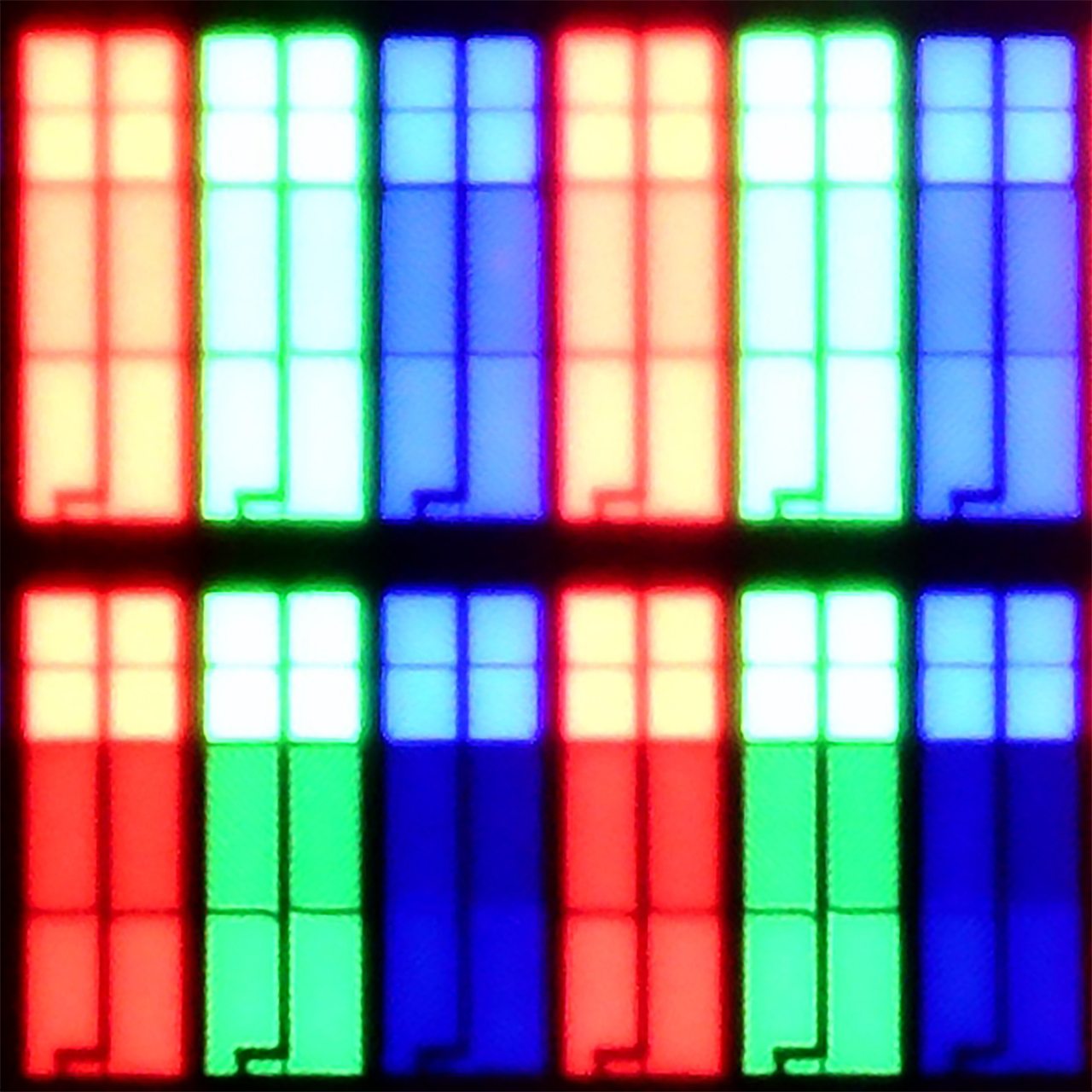
Panel uniformity and thermal imaging:
Backlight Type: Mini-LED QLED

Founder and originator of the "ChooseTV" portal

Journalist, reviewer, and columnist for the "ChooseTV" portal
See articles related to TCL C9K:
1/16/2025
3/6/2025
9/19/2025
